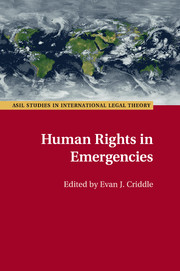Book contents
- Human Rights in Emergencies
- ASIL Studies in International Legal Theory
- Human Rights in Emergencies
- Copyright page
- Dedication
- Contents
- Contributors
- Book part
- Introduction
- Part I Designing a Human Rights Regime for Emergencies
- Part II Law, Politics, and Power
- 4 Emergency and Escape
- 5 The Cloak and Dagger Game of Derogation
- 6 The Law of Emergency and Reason of State
- 7 Human Rights Lawyers v. Carl Schmitt
- Part III Emerging Challenges
- Index
- References
4 - Emergency and Escape
Explaining Derogations from Human Rights Treaties
from Part II - Law, Politics, and Power
Published online by Cambridge University Press: 05 September 2016
- Human Rights in Emergencies
- ASIL Studies in International Legal Theory
- Human Rights in Emergencies
- Copyright page
- Dedication
- Contents
- Contributors
- Book part
- Introduction
- Part I Designing a Human Rights Regime for Emergencies
- Part II Law, Politics, and Power
- 4 Emergency and Escape
- 5 The Cloak and Dagger Game of Derogation
- 6 The Law of Emergency and Reason of State
- 7 Human Rights Lawyers v. Carl Schmitt
- Part III Emerging Challenges
- Index
- References
Summary

- Type
- Chapter
- Information
- Human Rights in Emergencies , pp. 83 - 123Publisher: Cambridge University PressPrint publication year: 2016

